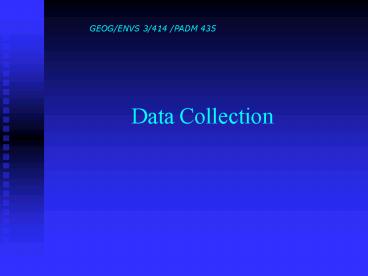Data Collection - PowerPoint PPT Presentation
1 / 10
Title:
Data Collection
Description:
There are over 2 dozen institutions involved in the standardization of ... Once you find data, you import it ... needs to build it over a period of time ... – PowerPoint PPT presentation
Number of Views:41
Avg rating:3.0/5.0
Title: Data Collection
1
Data Collection
GEOG/ENVS 3/414 /PADM 435
2
Outline
- Introduction
- Primary Geographic Data capture
- Secondary Geographic Data Capture
- Data Transfer from External Sources
- Capturing Attribute Data
- Managing a Data Acquisition Project
3
1. Introduction
- There are three ways to capture data
- From Primary Sources or Direct Measurement
- From Secondary Sources or from previous studies
or existing sources of information - Data transfer from external source
- You may digitize a map or improve existing data
as a part of the planning process in GIS data
capture - Data Capture can cost up to 85
- Data maintenance is also an important aspect
- Data dictionaries provide documentation about
data - Resolution is an important descriptor of data
- Two aspects of data quality must be considered in
data capture - Truth and labeling and
- Fitness for use
4
2. Primary Geographic Data Capture
- Vector Data Capture
- GPS used network of satellites. At least four are
available at any time on the earth. Based on the
travel time of signal from the satellite to a
ground receiver station. Accurate to about 5-10
m. Using differential GPS system, you can keep
one receiver fixed and other for measurements (
Rad box 10.1) - Survey measurements using Total Station
- Raster Data Capture
- Remote sensing E.g.. Thematic Mapper is based on
spectral signature of electromagnetic
reflectance. - Arial Photos
- Resolution is a descriptor of data
- Spatial
- Spectral
- Temporal
- Radiometric
5
3. Secondary Data Capture
- Raster Data capture using Scanning
- Resolution of scanner is important
- consideration 100 dots per inch ( 4 dots /mm) (
bi-level black and white and multiple gray level
8/16/32 bits - Can you think about reasons for scanning
- Documents/ plans may be available in Maps,
- Arial photos and maps are scanned and
geo-referenced to provide reference or context to
geographic analysis - aerial photos and images are scanned prior to
vectorization
6
3. Secondary Data Capture (contd)
- Vector Data Capture
- Digitize vector objects from a map or geographic
data source - Manual digitizing using existing map is simple,
cheap and easy ( Read Box on digitizing in the
text) - Vectorization is converting from raster to vector
- Rasterization is converting from vector to
raster. - Photogramettry is used to make measurements from
aerial photos and other image sources - COGO (coordinate geometry) is a vector method of
data capture. Bearings and distances are
converted into X and Y coordinates ( see
http//www.purplemath.com/modules/distform.htm)
7
4. Data Transfer from External Sources
- The best approach is to search the Internet
- US NDSI clearing house http//www.fgdc.gov
- Geographic network is another good source of
geographic information visit http//www.Geographi
cNetwork.com - See http//www.esri.com
- http//www.geocomm.com/
- See also free data link http//faculty.roosevelt.e
du/achet/dear.htm - See also http//www.nationalgeograpic.com
- For GEOWorld Data Directory visit
http//www.geoplace.com - For data Depot see http//www.gisdatadepot.com
- Visit EPA for environmental data
8
4.Data Transfer from External Sources(contd)
- Transfer takes place by direct read or via
intermediate file format. - There are over 2 dozen institutions involved in
the standardization of geographic data and
processing. - Once you find data, you import it
- Be ware of the most common data formats in Raster
and Vector formats - Familiarize yourself with the popular geographic
data formats ( see Table in the textbook)
9
5 Capturing Attribute Data
- Collected separately or together
- Simple using data logger or manual keyboard
entry, - Attribute data is generally entered in a tabular
format where the key ( common identifier column)
can be used to relate spatial and non-spatial
attributes - Metadata are a special kind of non-geometric data
10
6. Managing a Data Acquisition Project
- One needs to build it over a period of time
- Prepare data dictionaries
- There is a relationship between quality, speed
and price. - Can use in house or external resources
- Think about data quality issues fitness for use
and truth and labeling.































